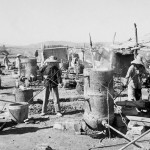
The Great Leap Forward was the name given to China’s Second Five Year Plan (1958-62). The Great Leap Forward was born from Mao Zedong’s impatience for industrial and manufacturing growth (in his words, “more, faster, better, cheaper”). While the First Five Year Plan had succeeded in stimulating rapid industrialisation and increased production, Mao was suspicious of Soviet models of economic development. Instead, Mao favoured an ideological shift in economic policy that would continue industrialisation but also move China towards agricultural collectivisation. This may have been driven by Mao’s suspicions about the growth of technology, the rise of a potentially bourgeois ‘expert’ class and the expanding divide between urban and rural production. Implemented in 1958, the Great Leap Forward had two objectives: to create an industrialised economy in order to ‘catch up’ with the West; and to transform China into a collectivised society, where socialist principles defined work, production, even people’s lives. History records the Great Leap Forward as a disaster. It gave rise to economic stagnation, led to food shortages and famine, and caused the deaths of untold millions.
The Great Leap Forward was announced by Mao at a party meeting in Nanjing in January 1958. China must follow a different path to socialism than the Soviet Union, Mao told delegates, by allowing the peasants to participate in economic modernisation and making more use of their labour. Rural collectivisation would be at the heart of this ‘Great Leap Forward’. Collectivised farms would better organise peasant labour, eliminate waste and inefficiency and greatly increase production. Cooperatives and collectivisation had been encouraged during the mid-1950s but it was not until the Great Leap Forward that the ‘people’s communes’ became official government policy. Initially, peasant families were organised into cooperatives of around 20 to 40 households. In 1955 Mao called for the enlargement of cooperatives, into communes of 100-300 households. The policy of collectivisation sparked debate within the Chinese Communist Party (CCP), with moderates like Zhou Enlai and Liu Shaoqi urging caution. Yet despite the discord within the Party, by late 1958 the entire Chinese countryside had been divided and organised into around 26,00 communes.

According to a CCP propaganda jingle from the late 1950s, “communism is paradise [and] the people’s communes are the way to get there”. In reality, the transition to communal living far from easy and created considerable misery. Most private property was confiscated, while land plots, farm buildings, tools and livestock were relinquished to the government. As targets were increased, even private homes were confiscated. The leadership of the people’s communes became fanatical about implementing government policy, increasing production, meeting targets and outdoing other communes. They demanded a regimented, almost militarised lifestyle; they also had overzealous expectations about work and production. According to historian Philip Short, “officially, everyone was supposed to have at least six hours’ sleep every two days, but some brigades boasted of working up to four or five days without stopping”. Other features of communal living included collective childcare, nursing homes, communal kitchens and the banning of cooking at home. Mao proclaimed that “communism means eating for free” and the communal dining halls allowed the government to control all aspects of food distribution and consumption. Most did not like the public dining halls, however, and there were issues with food supply – for example, food allocations intended to last for a week sometimes disappeared in a day.

The doubling of steel production was other of Mao’s initial goals of the Great Leap Forward. Steel targets further escalated during the period. In 1957 the annual steel production target was 5.35 million tonnes – but by May 1958 Mao called for the target to be raised to 10.7 million tonnes. An often stated goal was that China’s steel production should catch up to the Soviet Union by 1960 and eventually overtake that of Britain. At Mao’s insistence, mass steel production would be supplemented by the construction of basic backyard furnaces. Every family, every urban worker and every peasant was mobilised in the quest for steel production and gripped by ‘steel fever’. Backyard furnaces would be used to smelt (meltdown and purify) scrap iron – from old farming tools to household implements, such as cooking utensils and woks. Historians describe how these backyard furnaces transformed the landscape. According to Michael Lynch, smoke and flames filled the air as towns and villages glowed red, while Frank Dikötter writes that “China was dipped into a sea of fire”. One consequence of the backyard furnaces as the high demand for wood as fuel, which increased deforestation and denuded the landscape in many regions. The policy was abandoned when it was realised just how unproductive this process was: one tonne of iron from a backyard furnace cost twice the amount of that produced in a modern furnace. The steel produced by peasants was also low grade and unusable; much of it was taken to large secret dumps, even though officials kept encouraging its production.
As the targets for industrial and agricultural output increased, so too did the pressure on the people’s communes. This led to cadres and commune leaders inflating production figures, simply to keep pace with other communes. Some communes were referred to as ‘good news reporting stations’ while reaching a new high number was called ‘launching a sputnik’ (a reference to the Soviet Union’s recent launch of an artificial satellite into space). The communes, with Mao’s blessing, also experimented with radical agricultural practices, like the concentrated sowing of seeds, deep ploughing of the soil, close cropping and other ineffectual farming techniques. Most of these changes proved disastrous. The peasants, who had long experience with growing crops, were incredulous at the new policies – however after the Anti-Rightist campaigns of the 1950s, few were prepared to stand up to the government and local party cadres.
“The impetus for the GLF came from the CCP’s shocking recognition in late 1957 that Stalinist models of industrial growth were not suited to Chinese conditions. China’s population in 1950 was four times as big as that of the Soviet Union in the 1920s, while the Chinese standard of living was only half as high. In spite of universal collectivisation, farm production had not noticeably increased. From 1952 to 1957 the rural population had increased by about 9 per cent, while the city population had grown by about 30 per cent… The First Five-Year Plan had got results as expected, but to go ahead with more of the same would invite disaster.”
John K. Fairbank, historian
Frank Dikötter points out that Mao’s visits to the countryside were carefully stage-managed. Farmers, for example, were told to transplant rice along Mao’s route to give the impression of a big harvest. Crop production was also affected by the deployment of farmers in backyard steel production and mass labour projects, such as the construction of roads, large-scale irrigation projects, dam building and even the construction of the massive new Tiananmen Square in Beijing. The failed techniques, the absence of farmers and requisitioning of grain for feeding city workers were compounded by poor weather. By 1959 the harvests were insufficient for feeding the population, and the resulting famine devastated the peasant population. As Short concludes, the Great Leap Forward “ended in an apocalyptic failure.”

1. The Great Leap Forward was a slogan used to describe the Second Five Year Plan – and Mao’s program for China’s hasty transition into industrialised socialism.
2. Rural collectivisation forced peasants to live in huge communes of up to 300 households. Private property was seized by the state and people were forced to eat in communal dining halls.
3. The demand for increased steel production was a feature of the Great Leap Forward, with Mao claiming that China’s steel production would overtake that of Britain.
4. Every citizen was mobilised in the production of steel through the use of backyard furnaces. This program was a failure, producing useless steel and stripping the countryside of fuel.
5. Increased agricultural production was another key target, however, output fell due to failed agricultural experimentation and other factors. In addition, production figures were unreliable, often exaggerated or distorted by local officials.
© Alpha History 2018. Content on this page may not be republished or distributed without permission. For more information please refer to our Terms of Use.
This page was written by Rebecca Cairns. To reference this page, use the following citation:
Rebecca Cairns, “The First Five Year Plan”, Alpha History, accessed [today’s date], https://alphahistory.com/chineserevolution/first-five-year-plan/.
This website uses pinyin romanisations of Chinese words and names. For more information refer to this page.
